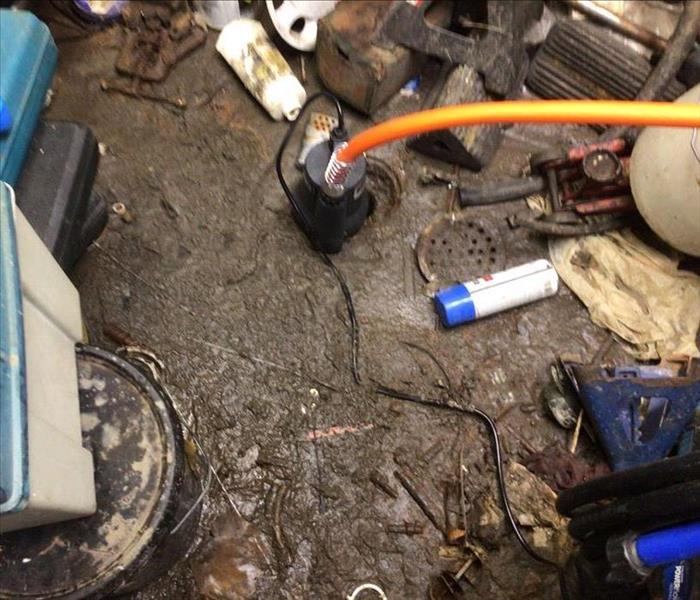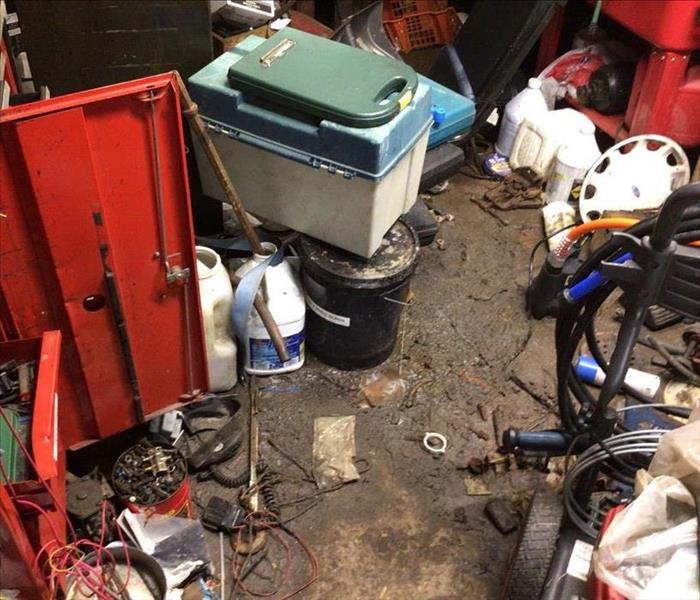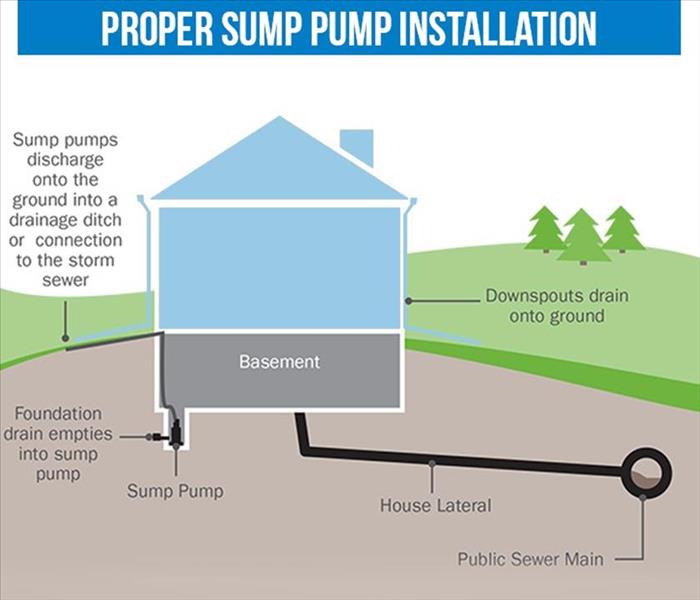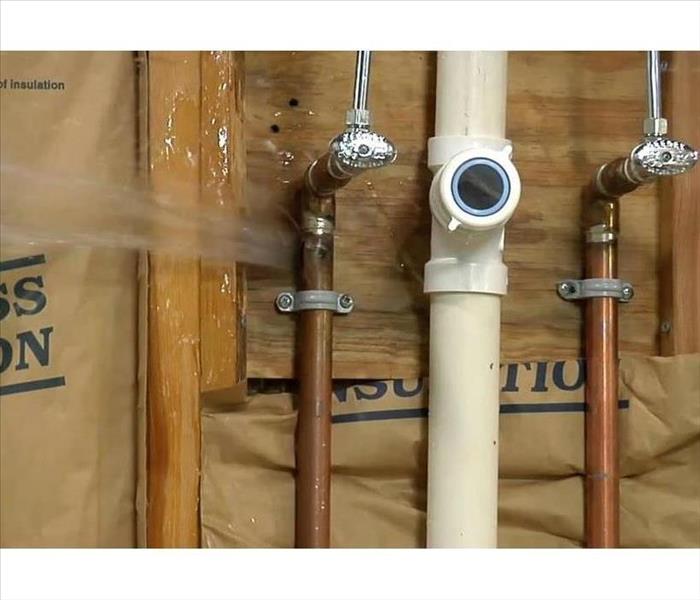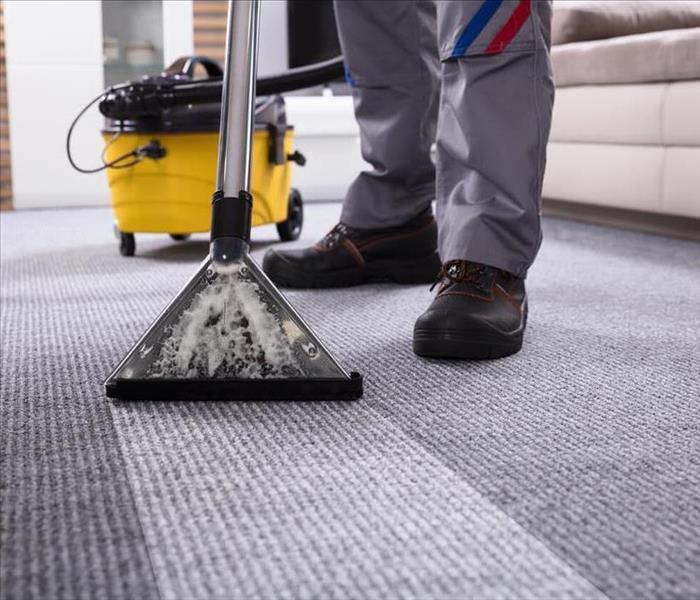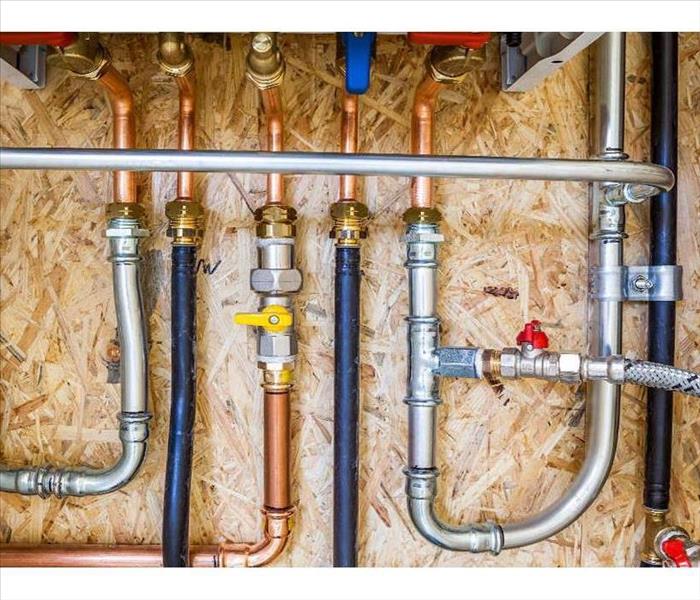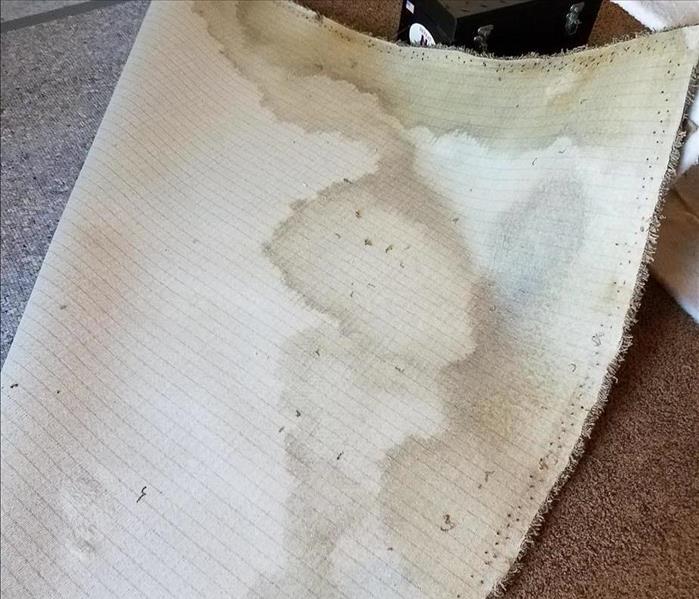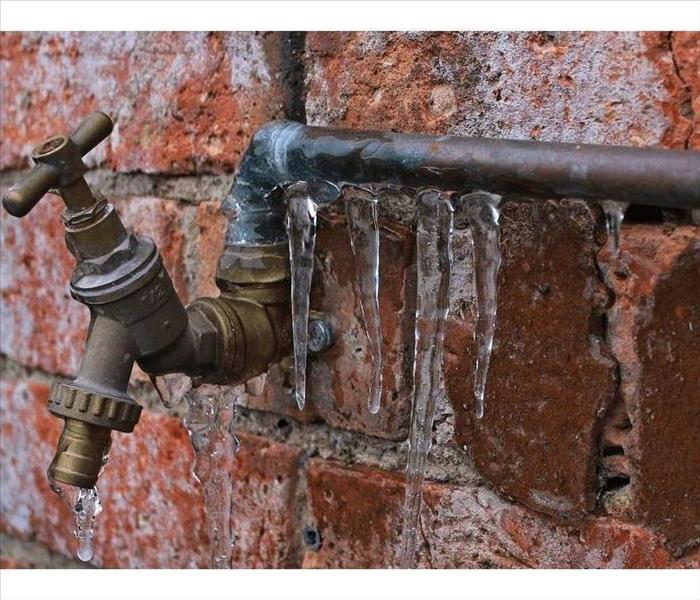Recent Water Damage Posts
Allegheny County 24 Hour Emergency Water Damage Service
3/25/2024 (Permalink)
SERVPRO of West Hills is available 24 hours a day for water emergencies, large or small. When you are dealing with water damage, immediate action is crucial. A delay of just a few hours can greatly increase the severity of the water damage.
We Answer the Phone Ready to Help
Call Today – (412) 299-5520
We understand that when you call us, you may be feeling confused, stressed, and vulnerable. You need an expert to guide you through this crisis. SERVPRO of West Hills has the specific water damage training and experience to help you through this tough time. We specialize in water damage restoration—in fact, it's the cornerstone of our business.
What to Expect
When you call, we will ask several questions regarding your water damage emergency. These questions will help us determine what equipment and resources to bring, including how many trained SERVPRO professionals may be needed.
Our SERVPRO Representative will ask several questions:
- Your name and contact information
- Your insurance information (if applicable)
- The street address of the water-damaged home or business
- When did the flooding or water damage occur?
- What caused the water damage (if known)?
- Is there electricity available (on-site)?
About SERVPRO of West Hills
SERVPRO of West Hills specializes in the cleanup and restoration of residential and commercial property after a fire, smoke, or water damage event. Our staff is highly trained in property damage restoration. From initial and ongoing training at SERVPRO’s corporate training facility to regular IICRC-industry certification, rest assured our staff is equipped with the knowledge to restore your property.
5 Keys to Prevent a Sewer Backup
7/28/2022 (Permalink)
While not all sewer backups are preventable, many of them are. To limit your chances of facing a backup there are easy precautions that can be taken. These following steps are among the most effective:
Install a Floor Drain Plug
These one-way plugs are installed below floor drain gates and protect against overloaded sewer systems from backing up into the house. This is a relatively inexpensive solution, though there are drawbacks. The essential float mechanism must be free of debris to operate properly.
Invest in a Backwater Valve
This solution requires the services of a registered plumber and is somewhat expensive. It is installed at the exit point of your building or in the underground pipe known as the sewer lateral line. It prevents a backup from entering your home.
Schedule Sewer Cleaning
If you have a septic system, make sure your tank is emptied on a regular basis. This is routine maintenance and will go a long way towards avoiding sewage in your basement.
Landscape Your Exterior Property
Storm damage can be caused by heavy rains that result in water coming into your basement, either through cracks in the foundation or faulty windows. By making sure the lawn slopes away from your home, allowing water to drain away, you reduce the chances of finding water in your home.
Put in a Standpipe
This simple, inexpensive measure is nothing more than putting in a pipe above your floor drain and attaching a watertight seal to the bottom. When dirty water backups it will go into the pipe and not all over your flooring. This method is only effective if the flooding does not reach higher than the length of the standpipe.
A sewer backup into your home will always require a storm cleanup team to address the situation safely and quickly. Look for a company that has the training and certifications to deal with contaminated water. SERVPRO of West Hills, North Washington County, and South Park/West Mifflin has all these qualifications. Give us a call for a free estimate at 412-299-5520!
3 Steps to Restore Your Business After a Sewage Backup
6/27/2022 (Permalink)
There are many different types of floods your business might endure, but few are more damaging than those that originate from a sewer. Black water, raw sewage and other contaminated contents can ruin building materials, stored contents, and office equipment. If you are currently dealing with this situation or want to be prepared for the future, you may want to become familiar with the steps a professional flood restoration company might take to restore your property.
- Mitigation
When professional flood damage technicians arrive, they will inspect the flooded areas and take whatever steps they can do to keep the sewer backup from spreading. For example, they will likely evacuate the rooms or the entire building so they can safely assess the situation before sealing off rooms or using portable sump pumps to drain away water that still might be flowing from contaminated sources.
- Building Material Inspection
Some building materials, such as drywall and insulation, are porous and can absorb sewage water. As such, an important part of the sewer cleanup process for your technicians is to inspect floors, ceilings and carpeting once the flood water is cleared to gauge the level of damage and which might need tearing out and replacing. Your flood specialists may perform flood cuts, which involves removing a section of a wall a few inches above the water line to know how seriously the interior and the components it contains might have been damaged.
- Restoration and Odor Removal
Sewage odor from a flooded toilet can linger long after the water has been drained away. Experienced technicians from a flood damage and mitigation service can give you several options for removing any unpleasant smells, from replacing floors and sections of drywall to ozone machines that cleanse the air and leave no trace of sewage behind.
When a sewer flood affects your business, the results can be devastating. However, understanding the process a professional sewer cleanup service may take to restore your building can help you feel confident about the results.
How a Sump Pump Can Prevent Flooding
5/23/2022 (Permalink)
Water will always seek the lowest level, which in most homes is the basement. Because of this, flooding in basement can occur in many ways including:
- Drainage tile failure
- Cracked or burst pipe
- Hot water tank failure
- Storm sewer backup
- Foundation cracks
- Broken washing machine hose
When one of these issues happens, give SERVPRO a call. Acting quickly can help avoid further damage. One of the best ways to keep your basement dry and to prevent flooding in the fir4st place is by installing a sump pump.
Types of Sump Pumps
Sump pumps are small pumps that move water from your basement out of your home. There are two different types of primary sump pumps:
- Submersible – contain the pump and motor in one unit and sit submerged in a basin. They are quieter and less obtrusive but are harder to fix and a little more expensive.
- Pedestal – mounted above the floor and consist of a separate pump and a motor that cannot get wet. They are less expensive and easier to repair but are noisier and more obtrusive.
Submersible pumps are usually found in finished basements, whereas pedestal pumps are found in unfinished basements.
How Do Sump Pumps Work?
When pressure builds upon the foundation walls, cracks will form and allow water to leak through. Sump pumps are necessary because they remove water from around the foundation and not allowing that water to slip through. A sump pit collects water from around the foundation, and then pipes attached to the pump push water through a discharge pipe, out of the house, and away from the building. These pipes have a one-way valve to move the water in a single direction, which ensures water does not come right back up.
Sump pumps require electricity, so if a storm were to knock out the power, that would render it useless. A battery backup helps provide some extra security during a power outage. When the power goes out and water rises in the basin, the float switch is triggered and allows your pump to operate normally. Make sure to occasionally check those batteries!
Basement flooding can be costly to repair but losing personal items and family heirlooms can make it a tragedy. Make sure to waterproof your basement as much as possible and take the right preventative steps.
Common Pipe Noises and How to Address Them
5/4/2022 (Permalink)
A noisy pipe is not just an inconvenience. It could also be evidence that something is wrong with your plumbing system.
If the problem is not addressed, it could lead to a pipe break that causes major damage to your home. Some common pipe noises are:
- Banging
- Hammering
- Whistling
These sounds each signal a potential issue with your plumbing system. Below is a discussion of the causes of these noises and how to address them.
Banging and Hammering
Banging or hammering occurs when there is a sudden stop in the flow of water. Momentum causes the water to slam against the sides of the pipes. This can damage the joints and connections, which can lead to a pipe burst.
To combat this issue, start by inspecting the pipes for any signs of vibration or looseness. If your pipes bang against the wood while vibrating, you can install a rubber pad between the wood and the pipe to reduce the noise.
You can also try installing an air chamber, also called an anti-hammer device. There are several different types, all of which fill up with air that absorbs the sudden increase in water pressure. This, in turn, reduces the risk of a pipe break.
Whistling
Your pipes may make a whistling noise when water flows quickly through an obstructed area. This can occur when a faucet is running.
To determine where the noise is coming from, turn a faucet on and see if you hear the whistling. If you don’t, turn that faucet off and move on to the next one. Once you have found the source of the whistling, you can take that faucet off and move on to the next one. Once you have found the source of the whistling, you can take that faucet apart and replace the brass screw and the washer.
By performing the above maintenance tips in your home, you can avoid a burst pipe. If you do find yourself dealing with a pipe break, however, try calling water repair specialists. They not only fix a broken pipe, but they also can assist with the cleanup process.
Ways to Recover From Water Damage
4/11/2022 (Permalink)
Flooding, extreme weather and broken pipes can quickly cause a home to fill with water, threatening the integrity of a building in the process. Once the water is pumped out, it leaves behind a trail of damaged household items, some of which may feel irreplaceable. If you find that your home has recently suffered from severe water damage, it may feel overwhelming to navigate the process. The following are ways to ensure that you salvage the maximum amount possible and return your home to normal.
Remove Water ASAP
Leaving large amounts of stagnant water unattended to for days can lead to mold, which can quickly get out of hand. Flooding in the basement is especially dangerous, as it can result in the following problems.
- Mold, mildew, or fungus growing and spreading across rooms
- Damage to appliances, such as washer/dryer units or water heaters
- Cracks in the foundation of the house
- Electrical shock from contact with exposed wires
For minor fixes, such as a dripping pipe, a dehumidifier can clean the mess in a matter of hours. These can either be rented or purchased from a reputable dealer.
Contact Professionals for Major Cleanup
In a scenario where is simply too much water to remove through simple measures, professional restoration services can be contacted to take care of things. Restoration servicers specialize in water damage repair and know the best methods for restoring your home.
Dry Off Wet Items
After the water cleanup is completed, the restoration of recovered personal items comes into focus. In all cases, only trained professionals should handle electronics damaged by water. Air-drying works for most non-electronics, although not all belongings will be the same after suffering damage.
The dangers of stagnant water in a residence demand immediate and swift action. Finding and confronting water damage in a timely manner can get your family back on track as soon as possible.
Common Plumbing Materials and Their Uses
4/11/2022 (Permalink)
Learn About Your Pipes
Most people don't get curious about their plumbing until something like supply line damage comes along. If you'd like to be prepared before this happens, you should learn about your pipes. The type you have can tell you a lot about what kind of damage can happen or how long they will last.
Case Study: Plastic
There are a couple types of plastic you will find out there. The first is CPVC, which usually carries a warranty of 5-8 years. It is a rigid plastic prone to supply line leak at the joints and easy to damage, especially in a freeze. They are usually chosen because they are cheap and easy to install. An upgraded plastic option is PEX, with a warranty of 25 years. Some benefits are:
- Easy to install with fewer fittings
- Flexible so it can fit in small spaces
- Durable and corrosion resistant
- Can withstand temperatures ranging from 30 degrees to 200 degrees
Case Study: Metal
Copper was the industry standard for a long time, especially for exposed piping. It is still respected by most plumbers and lasts approximately 40 years. Soft copper can be bent to fit in tight places. However, pin hole damage is common to this type of pipe. It is also very expensive. If you have an older home, you may have galvanized iron piping. This type of pipe almost always falls prey to corrosion or rust and supply line damage and is not recommended anymore.
Case Study: Braided
Stainless steel braided supply lines are rubber tubes covered by a woven steel jacket. They usually come with a life-time warranty. They are extremely durable, and usually only cause a bathroom leak if damaged by harsh chemical cleaning supplies stored nearby. Also known as SS lines, they are very flexible and are corrosion resistant. Aesthetically they are very attractive- the woven metal appears like fabric.
Supply line damage can be repaired, but it may also be a blessing in disguise. A leak could uncover problematic plumbing that should be upgraded to something better. Get to know your pipes to keep your home running smoothly.
Does Water Damage Ruin Carpet?
6/18/2021 (Permalink)
A pipe break, leak, or flood can ruin carpeting. Even if an incident involves clean water, prompt drying is necessary to prevent mold growth. Homeowners should consider the following factors when weighing the options of restoring or replacing flooring.
Water Categories
The extent of damage to the carpet depends on the level of contamination in water. Mitigation professionals classify water damage into three categories:
- Category One water is clean and treated
- Category Two water is contaminated but does not contain solid waste
- Category Three water is heavily contaminated and may contain solid waste
Carpeting saturated with Category One water from a pipe break can be dried, but it is important to mitigate damage quickly to prevent mold growth. Porous flooring exposed to contaminated water may run a higher risk of developing mold. Depending on the duration of time since the damage occurred, it may be possible to clean carpeting, or porous flooring material may need to be torn up, disposed of, and replaced.
The Condition of Carpeting
Carpet that has remained waterlogged for longer than 24 hours runs a higher risk of supporting mold growth. Moisture can penetrate to the underlayment and subfloor where hidden mold may multiply. It is important to dry every layer of flooring.
Advice From Restoration Experts
A service that specializes in cleaning up residential water damage can advise homeowners about whether flooring should be restored or replaced. Trained professionals will factor in the type of damage and condition of the flooring. It is important to allow the affected area to dry completely before replacing flooring.
Water damage caused by a pipe break can simply be dried if homeowners act quickly. Replacing carpeting exposed to contaminated water may be safer in the long run. Mold can result in costly damage to a residence. Seek a recommendation from a damage mitigation and restoration company.
The Facts About Water Damage
5/27/2021 (Permalink)
If you are a conscientious homeowner, you do your best to keep up with maintenance and necessary repairs. While there are things you can do to prevent disasters and emergencies in the home, you cannot always prepare for everything. Something such as a pipe burst or sewer backup can inflict widespread damage. It is important to understand these issues and how professional flood remediation teams can get your home back into good condition.
Typical Causes of Water Damage
Coming home and seeing flooding can be a nightmare. Water can find its way into the house in many ways. Even minor issues can turn into big problems. Here are some of the most common culprits:
- Roof leaks
- Broken or leaky pipes
- Leaky or bursting appliances such as a water heater or dishwasher
- Backed-up sewer
The Assessment
You should call a professional cleanup team and your homeowner's insurance company immediately after you discover a pipe burst or another cause of the flood. Cleanup crews will first inspect the home and determine the cause of the issue. The team will review the extent of the damage, come up with a restoration plan and share the timeline with you.
Removing the Water
Incoming water from a broken water line or severe weather can leave large amounts of water on the floor, walls, ceilings, and your belongings. Technicians will use industrial-strength machines to extract all standing water. Crews will also take the machines to furniture, carpet, and materials that are saturated with water.
Dry it Up
It is not enough to get rid of the water. A professional water removal team will also thoroughly dry the affected area. The technicians will use fans and dehumidifiers to make sure your entire home is moisture-free.
Sanitize and Rebuild
To keep mold away, the crews will disinfect all affected materials. For any materials the technicians can't save, they'll rebuild and restore your home.
Do not let a pipe burst or other problems keep you out of your home too long. A disaster relief company has the right processes and tools to make your house safe again.
Six Essential Steps For Sewage Cleanup
4/27/2021 (Permalink)
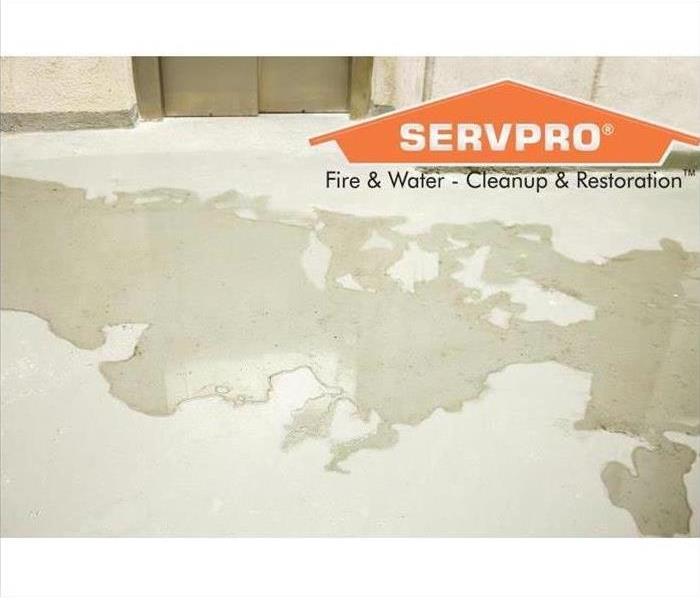
Whether due to a flooded toilet or a backed-up sewer line, unique cleaning procedures are required to ensure the building is properly sanitized. Additionally, special equipment, gear, and precautionary actions are needed to avoid harm to the individuals cleaning the harmful toxins and bacteria. For this reason, it is important to always hire a water and sewage cleanup company to deal with this situation. Here are the steps that the specialist will take when cleaning the area.
Preparation and Inspection
The specialist will begin by preparing the area and inspecting it to assess the extent of the damage. The preparation process will include completely evacuating the area and putting on the necessary gear including coveralls, rubber boots, rubber gloves, and eye protection.
Removal of Water and Sewage
Next, the specialist will use pumps and vacuums to remove all standing water and sewer backup from the area. This prevents even more damage from occurring.
Removal of Contaminated Surfaces
After the water is removed, the specialist will continue with sewage cleanup by removing flooring, walls, and other surfaces that have been contaminated. Items that can be restored will be separated for later cleaning.
Professional Drying
Once all damaged surfaces and items are removed, dehumidifiers, air movers, and other professional equipment are used to dry the area. This can take several hours or even days to finish.
Cleaning and Sanitizing
The specialist will then thoroughly clean and sanitize all salvageable items and areas. In addition to removing harmful bacteria, this process might include mold removal and deodorization.
Restoration and Reconstruction
Last, the specialist will work on restoring your business through reconstruction and replacement. This can include installing new walls and floors, replacing furniture, and repainting surfaces.
All these six steps of the sewage cleanup process are necessary for safely restoring your building and resuming business as normal. Calling an experienced water restoration company is the best place to start.
Winter Storms & Polar Vortex Preparation
2/23/2021 (Permalink)
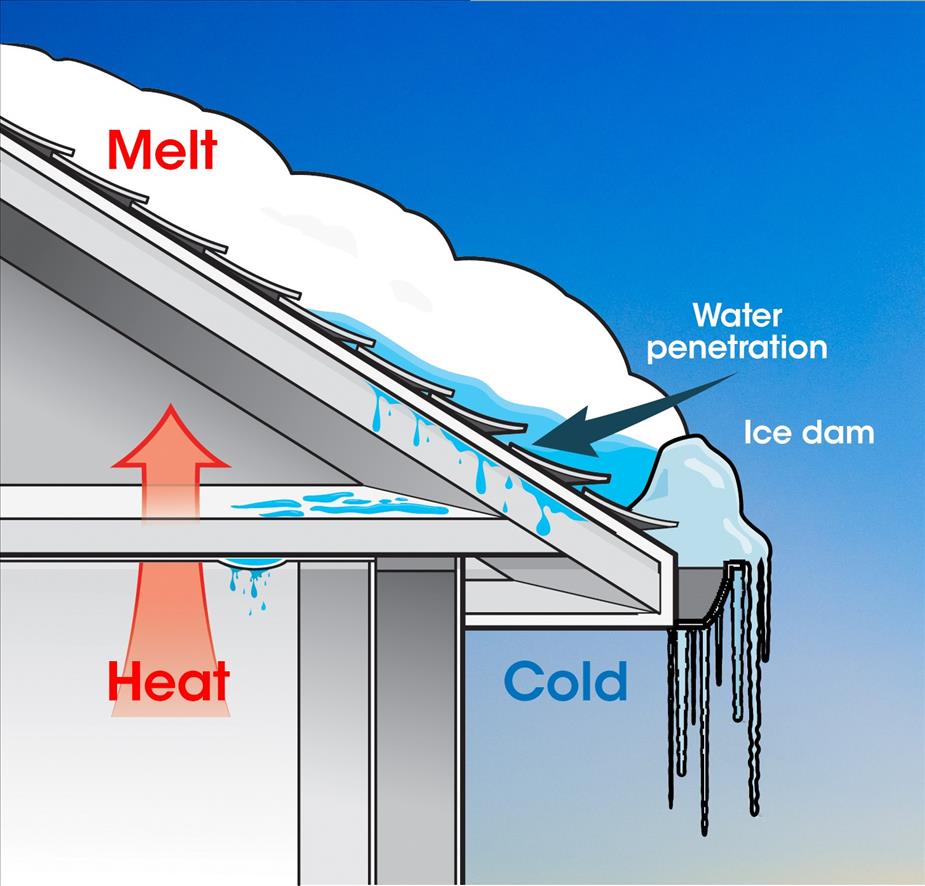 How ice dams are formed.
How ice dams are formed.
There is always talk this time of year about when the next “polar vortex” is on the way, but what is this phenomenon? A polar vortex is a large area of low pressure and cold air surrounding both Earth’s poles. During the winter, the polar vortex will expand and send cold air south with the jet stream. Arctic air can bring abnormally low temperatures to places that do not typically get too cold. This can cause complications in buildings if precautionary steps are not taken. When colder temperatures hit, people will prepare themselves with hats, gloves, and warm clothes. That level of preparation should also take place for homes and businesses.
Problems that can arise during these conditions:
- Ice damming happens when indoor heating melts the snow on the roof above a conditioned space forcing water to move to and freeze on the roof eaves. A ridge of ice then forms and prevents melting snow to drain off the roof, thus allowing water to move into the structure through cracks in the roof.
- Problems with the foundation can be caused by a frost heave, which is when freezing temperatures and water penetrate the ground, forming ice, and then forcing the soil to swell and push up against the foundation. Added pressure on the foundation walls can create cracks in the concrete where water can seep through.
- Frozen pipes occur when the temperature is cold enough to freeze the water inside of the pipe. Water molecules expand when frozen to create a blockage of ice within the pipe causing unfrozen water to build up and increase pressure on that pipe. An increase in pressure can thus raise the chance of a pipe rupturing.
From all these scenarios, water damage can appear inside and possibly lead to the growth of mold. Keep an eye on any problem areas you may have to make sure things are not worsening.
Steps you can take to prepare:
- Make sure your top floor or attic is well insulated.
- Try to clean the snow off your roof as much as possible.
- Wrap pipes with added insulation.
- Seal in any foundation cracks.
- To avoid freezing, let your faucets drip to keep water flowing.
- If ice damming is a reoccurring issue, install heat cables along the edges of the roof.
- Shut off exterior water sources that are not insulated.
- If you are away for an extended period, keep temperature in the structure at 55°F or higher.
Make sure to have extra supplies and to stay informed on weather events coming to the area. It is best to be proactive during the winter months because you never know what mother nature will bring!
Are You Prepared for Water Damage?
4/18/2019 (Permalink)
Imagine a storm event which causes your family home in Pittsburgh to severely flood. You may find yourself having to temporarily leave your family home for a short period of time.
Before SERVPRO of West Hills is called in to clean up the aftermath of this Storm Event, because we want to help, we recommend that families prepare in advance a mini kit or box or bag in the event they may have to leave the family home for a few days. Remember a few doses of necessary medications and foods, some water, mini first aid kit and favorite home items like books and toys. Make a list of emergency contacts on an index card, and have it laminated in the event water would damage all your electronic devices, which store your contact information.
Attic Mold After Water Damage
4/18/2019 (Permalink)
This is a frank discussion about proper attic and roof ventilation in order to prevent the onset of mold issues and shingle warranties in your properties. All modern construction should be code inspected to ensure that the proper ventilation was done at the time of construction, but, sadly, often doesn't due to inspections missing these critical observations. Older homes should be evaluated to ensure that proper ventilation is in place and working sufficiently, and the ventilation system(s) should be upgraded whenever there is going to be a probability of having new roof installations. Remember too, to pay attention to the chimney. Flashing can become loose over time, and there may be less obvious leaks related to the chimney. Mold must eat, and it feeds on moisture.
Too Much Rain Can Cause Water Damage
4/17/2019 (Permalink)
We cannot forecast the number of major storm events, but when storm damage happens, please keep it green with SERVPRO WEST HILLS. The National Oceanic & Atmospheric Assoc. reported that in 2016, flooding alone resulted in an estimated collective $99 billion dollars in loss. Also, remember to review your homeowner's insurance policy to be certain that the policy covers sewer back up. Many homeowners insurance policies DO NOT cover this. You may add $5,000 or $10,000 worth of sewer back up coverage, by adding an ENDORSEMENT to the existing homeowners insurance policy, if the coverage is currently not available on your existing policy. SERVPRO WEST HILLS is here to help when storm events result in disaster for your home or business.
WATER AND FIRE: IN THE EVENT OF LOSS, WHAT ABOUT YOUR VALUABLES?
4/16/2019 (Permalink)
WATER and FIRE LOSS: When these type of disasters occur, contents in your home can be adversely effected. You can certainly look to rely on the contents coverage on your homeowners policy, but more than likely, you'll find yourself disappointed to learn that there are special sublimits for certain categories of valuables, including but not limited to jewelry, fine art, silverware, and other collectibles. A separate valuable articles rider/endorsement can adequately protect these items. Additionally, consider taking time out of your busy week to either video and/or photograph rooms and valuable items. Remember to print out photos, and secure them in an alternate location in the event of a water or fire loss (like a safety deposit box, or your Mother's home).
Spring Showers
4/27/2018 (Permalink)
We hope Spring brings you more flowers and less showers, but if you experience water damage in your home or auto, we are here to help with solutions. When it becomes warmer, and we park outside, we may forget to close those windows, and then there is a massive, heavy over night rain storm. Our vehicle becomes water saturated. Then you may begin to have an itchy nose, and smell that mold smell. Next, you vacuum, and put the little scent tree on your rearview mirror--but oh, that smell. The same situation of leaving that open window in the house, and then, oh, that smell! We live in such a damp geographical region, thankful for our abundant drinking water source, but--mold is everywhere, and our mold estimates are free.
When Pipes Freeze
1/23/2018 (Permalink)
When temperatures drop and stay below 32 degrees for a full three days, it is highly likely that pipes can freeze. The following thaw that comes along after the freeze is when the pipes are likely to burst, and the result is not only a broken pipe, but water damage. Water damage to floors, carpets, dry wall and plaster, personal property, and appliances. The damage list can--sadly--go on and on. Remember, during the frigid, wintery season that you do NOT drop the thermostat below 58 degrees when you go out, and if the building is much older, a light drip, drip in both cold and hot spigots in all locations in the home. Make sure you know where your water main shut off is in your home. Also, does it turn easily? If no, a little spritz of WD-40 on the valve to help it move easily in the event there is an issue where the water main must be shut off, you won't be struggling with an uncooperative valve in an emergency.





 24/7 Emergency Service
24/7 Emergency Service
